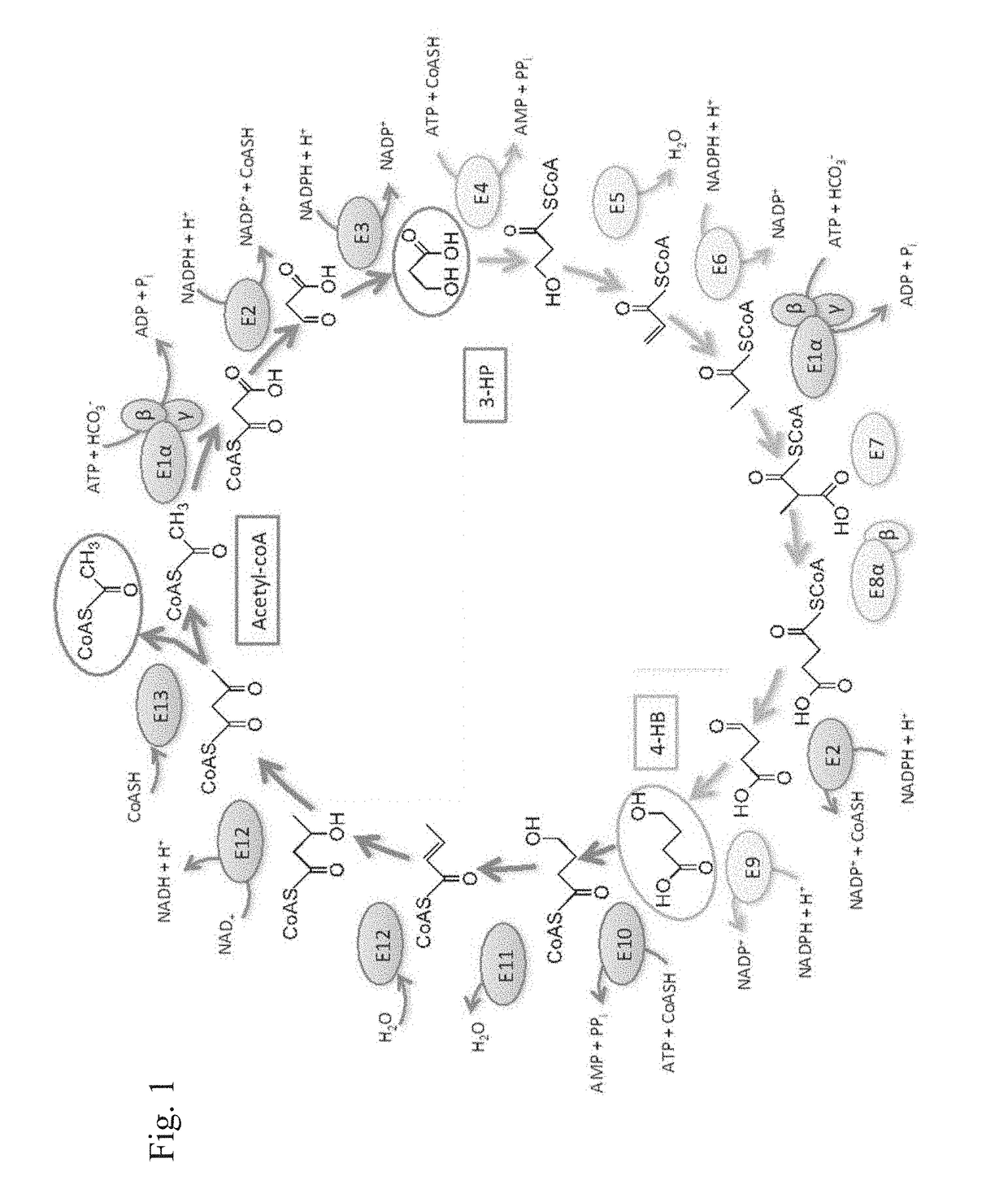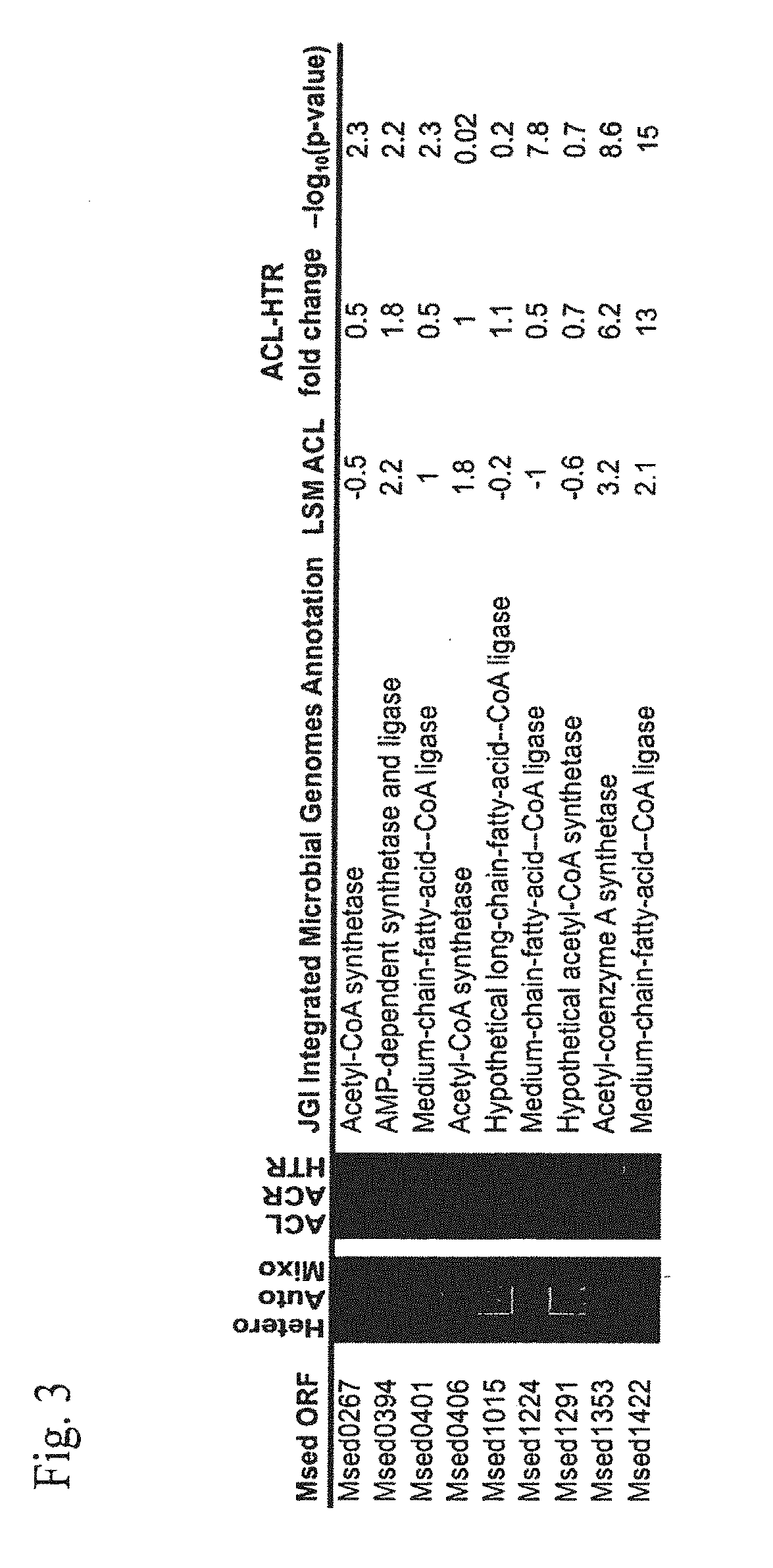Sequestration of carbon dioxide with hydrogen to useful products
- Summary
- Abstract
- Description
- Claims
- Application Information
AI Technical Summary
Benefits of technology
Problems solved by technology
Method used
Image
Examples
example 1
[0187]Metallosphaera sedula is an extremely thermoacidophilic archaeon that grows heterotrophically on peptides, and chemolithoautotrophically on hydrogen, sulfur, or reduced metals as energy sources. During autotrophic growth, CO2 is incorporated into cellular carbon via the 3-hydroxypropionate / 4-hydroxybutyrate cycle (3HP / 4HB). To date, all steps in the pathway have been connected to enzymes encoded in specific genes, except for the one responsible for ligation of coenzyme A (CoA) to 4-hydroxybutyrate (4HB). While several candidates for this step have been identified through bioinformatic analysis of the M. sedula genome, none have been shown to catalyze this biotransformation. Here, transcriptomic analysis of cells grown under strict H2—CO2 autotrophy uncovered two additional candidates, encoded in Msed_0406 and Msed_0394. Recombinant versions of these enzymes catalyzed the ligation of CoA to 4HB, with similar affinities for 4HB (Km values of 1.9 and 1.5 mM for Msed_0406 and Msed...
example 2
Production of an Industrial Chemical Using Hydrogen and Carbon Dioxide
[0237]Microorganisms can be engineered to produce useful products, including chemicals and fuels from sugars derived from renewable feedstocks, such as plant biomass. An alternative method is to utilize low potential reducing power from non-biomass sources, such as hydrogen gas or electricity, to reduce carbon dioxide directly into products. This approach circumvents the overall low efficiency of photosynthesis and the production of sugar intermediates. While significant advances have been made in manipulating microorganisms to produce useful products from organic substrates, engineering them to utilize carbon dioxide and hydrogen gas has not been reported. Herein, we describe a novel temperature-dependent approach that confers upon a microorganism, the archaeon Pyrococcus furiosus, that grows optimally on carbohydrates at 100° C., the capacity to utilize carbon dioxide, a reaction that it does not accomplish natu...
example 3
Construction of P. furiosus Strains PF506 and MW56 Containing the SP1 Pathway for 3-Hydroxypropionate Production and the Control Strain MW43 for Optimizing Production of M. sedula Enzymes in P. furiosus
[0255]The five genes encoding the three enzymes (E1αβγ, E2, E3) of the M. sedula 3-HP / 4-HB CO2 fixation sub pathway I (SP1) are scattered across the M. sedula genome (FIG. 24). These genes have been combined into a single artificial operon using overlapping SOE-PCR (splicing by overlap extension and PCR, Horton, et al. 1989. Gene 77, 61), followed by integration of the expression cassette into the P. furiosus genome. Transcription of the artificial SP1 operon in P. furiosus is driven by Pslp, the native, constitutive promoter of the highly expressed S-layer protein (Chandrayan, S. K. et al. 2012. J. Biol. Chem. 287, 3257-3264). To optimize translation of the SP1 genes in P. furiosus, the native M. sedula ribosomal binding sites (RBSs) for E1γ, E2 and E3 were replaced with optimal P. ...
PUM
| Property | Measurement | Unit |
|---|---|---|
| temperature | aaaaa | aaaaa |
| temperature | aaaaa | aaaaa |
| ionic strength | aaaaa | aaaaa |
Abstract
Description
Claims
Application Information
 Login to View More
Login to View More - R&D
- Intellectual Property
- Life Sciences
- Materials
- Tech Scout
- Unparalleled Data Quality
- Higher Quality Content
- 60% Fewer Hallucinations
Browse by: Latest US Patents, China's latest patents, Technical Efficacy Thesaurus, Application Domain, Technology Topic, Popular Technical Reports.
© 2025 PatSnap. All rights reserved.Legal|Privacy policy|Modern Slavery Act Transparency Statement|Sitemap|About US| Contact US: help@patsnap.com



